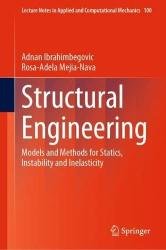Structural Engineering: Models and Methods for Statics, Instability and Inelasticity
- Добавил: literator
- Дата: 26-02-2023, 11:52
- Комментариев: 0
 Название: Structural Engineering: Models and Methods for Statics, Instability and Inelasticity
Название: Structural Engineering: Models and Methods for Statics, Instability and InelasticityАвтор: Adnan Ibrahimbegovic, Rosa-Adela Mejia-Nava
Издательство: Springer
Серия: Lecture Notes in Applied and Computational Mechanics
Год: 2023
Страниц: 542
Язык: английский
Формат: pdf (true)
Размер: 10.9 MB
This book presents a novel approach to the classical scientific discipline of Structural Engineering, which is inspired by numerous current applications from domains of Civil, Mechanical or Aerospace Engineering. The main goal of this book is to help with making the best choice between accuracy and efficiency, when it comes to building the most suitable structural models by practising engineers using modern computational tools available in commercial software products (SAP, FEAP, ANSYS …) for which we have carried out many developments that have been become the main reference in the field. Any development of this kind is not a mere modification of discrete approximation, but a thorough treatment with a sound theoretical formulation based upon Hu-Washizu variational principle with independent rotation field, its corresponding regularization and finally the most appropriate finite element interpolation that can match those used for structural elements. Proposed approach allows us to provide a unified discrete approximation of complex structural assemblies and greatly simplify the modeling task for structural engineers. Thus, in conclusion, this book can also be perceived as the theoretical manual for using modern computer models successfully by practising engineers.
The Structural Engineering is perhaps the most classical scientific discipline, developed well before the computer-based simulations have become dominant in current engineering practice. These skills are used to develop the simplified models capable of providing the most efficient solution methods with sufficient accuracy to numerous problems from domains of Civil, Mechanical or Aerospace Engineering.
Our main interest in present work pertains to the material structures, including man-made objects, such as buildings and machines or vehicles, and natural objects, such as biological organisms, rather than the abstract structures, including data structures in Computer Science and musical form. The main goal of this book is to help with the choice of model for any such material structure that is made by engineers in order to eliminate the unnecessary details by using certain simplifying hypotheses, and provide accompanying methods to accomplish the task on hands. Contrary to many classical works, the approach we follow relies heavily on the most advanced models developed by using the finite element method, with an ambition to present not only the basis of linear theory, but also the nonlinear theory dealing with structure instability and inelasticity. The nonlinear problems studied in this book are extremely difficult to solve other than by numerical modeling and the finite element method. For that reason, the first important role of a specialist in structural engineering is that of verification, testing the quality of the discrete approximation and the numerical methods available in a given computer code.
Contents:
1. Introduction
2. Truss Model: General Theorems and Methods of Force, Displacement and Finite Elements
3. Beam Models: Refinement and Reduction
4. Plate Models: Validation and Verification
5. Solids, Membranes and Shells with Drilling Rotations: Complex Structures
6. Large Displacements and Instability: Buckling Versus Nonlinear Instability
7. Inelasticity: Ultimate Load and Localized Failure
8. Brief on Mulitscale, Dynamics and Probability
Скачать Structural Engineering: Models and Methods for Statics, Instability and Inelasticity
Внимание
Уважаемый посетитель, Вы зашли на сайт как незарегистрированный пользователь.
Мы рекомендуем Вам зарегистрироваться либо войти на сайт под своим именем.
Уважаемый посетитель, Вы зашли на сайт как незарегистрированный пользователь.
Мы рекомендуем Вам зарегистрироваться либо войти на сайт под своим именем.
Информация
Посетители, находящиеся в группе Гости, не могут оставлять комментарии к данной публикации.
Посетители, находящиеся в группе Гости, не могут оставлять комментарии к данной публикации.
